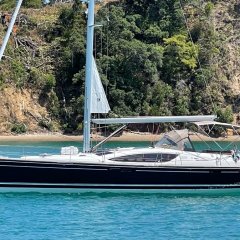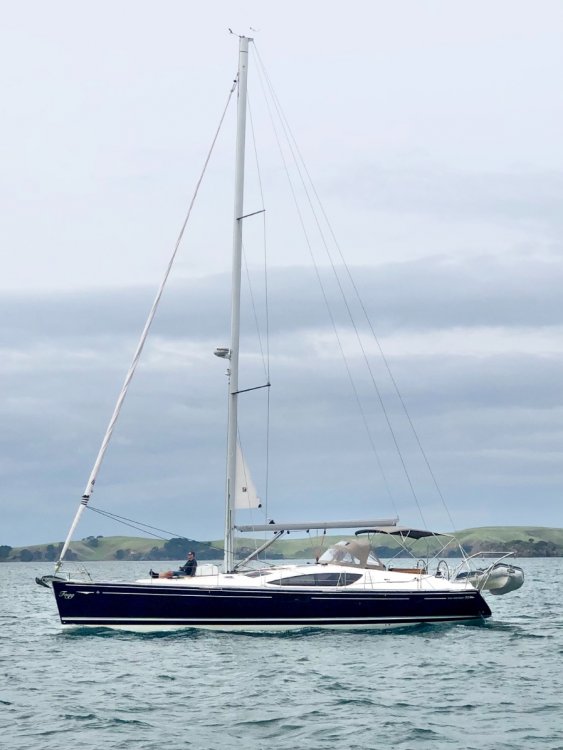-
Content Count
4,296 -
Joined
-
Last visited
-
Days Won
47
Content Type
Profiles
Media Demo
Forums
Gallery
Calendar
Store
Posts posted by Fogg
-
-
38 minutes ago, aardvarkash10 said:
I didn't say they are THE culprits.
But you'd have to be a mental midget to think that the huge fleet of moored recreational boats in Auckland hasn't in some way contributed to the spread of invasive species. A quick look up the Tamaki (hell, go past any 20 boats moored in the Wairoa at Clevedon...) will show you the level of contamination some get to.
I watched one nearly sink in the Tamaki, and when it was hauled there was more fanworm than hull.

1 What % of boats in Auck look like that? Very few I’m guessing. Any stats anyone? Another blanket rule to cater for the exceptions at the expense of the mostly well behaved masses. Instead, tell the Auckland Harbour Master to stop eating donuts and go out and inspect the usual culprit areas and enforce existing rules.
2. Still not addressing the fact it’s invasive. Stop letting it in and stop persecuting innocent NZ boaties who didn’t bring it in and who get caught in the middle. At very least tackle the invasion-by-foreign-ship AS WELL rather than exempting them altogether. Which totally demotivates me to do my part.
-
 1
1
-
-
Ordinary people rarely achieve extraordinary things so I get the whole scene has its fair share of ‘rock star’ personas. But it sounds like the egos are now so overinflated that rationale decisions are fast going out of the window.
Losing interest (again)…
-
 1
1
-
-
3 hours ago, raz88 said:
This is true, but the thought of the marinas having to keep their pontoons clean terrifies me, cos I know where the cost will be passed on to...
Shame the marinas can’t paint the piles & pontoons with same stuff the ships & subs use. Would save all the boats in the marinas needing it!
Years ago before I knew better a mate and I did a non-cash trade with a guy working at Cardiff docks (some furniture for a drum of commercial “bottom paint”). We didn’t ask what was in it but painted it on our little 27 footer on an estuary in the West Country. Came back to the boat 2 weeks later and everything within visible radius was clean & shiny as new including our marina finger, piles, other boats etc. Those were the days…
-
 1
1
-
-
Yeah because the marinas around NZ are littered with burnt-out wrecks and dead bodies caused from onboard electrical problems, right?
-
Yes what is the evidence for small pleasure boat being the culprits?
Something doesn't add up here...
Zoom out and look at a map of the world. What we are saying is that that tiny dot of a country down the bottom right doesn't like some of it's pleasure craft moving around its own coastline in case it might infect itself with some of it's own stuff???
If it is our own stuff, then what's the problem? It's dynamic environment and we can't expect to 'freeze time' and keep everything unchanged forever.
But if it's not our own stuff but coming from bottoms of ships entering NZ from other parts of the world isn't that the primary problem to address directly i.e. stop it coming in in the first place, rather than exempting the ships and persecuting the boats already in NZ who then move it around?
Or am I missing something???
-
 1
1
-
 1
1
-
-
From the red & green map itself:
“This map / plan is illustrative only and all information should be independently verified on site before taking any action. Copyright Auckland Council. Whilst due
care has been taken, Auckland Council gives no warranty as to the accuracy and plan completeness
of any information on this map / plan and accepts no liability for any error, omission or use of the information.”Given this disclaimer it can’t be relied upon. And so if there are no physical notices at any of the locations themselves then it’s all very ambiguous.
Based on this uncertainty, I think you’re safe to continue a light rubbing of your waterline, leading edges & foils when you go for your regular swim at anchor, wherever you are.
-
Ok so no change with that then.
-
But isn’t that to protect contractors from damaging my boat? What if my boat damages you? I have insurance that covers financial liability for damage or injury but could I still be prosecuted by Woke-safe?
-
But what about the other way around? What if I’m paying someone to do work on my boat and they hurt themselves - possibly whilst I’m not even there? Am I now providing a place of work to contractors that I must keep safe?
-
8 hours ago, CarpeDiem said:
Even at 60% loss they are rediculously oversized.
You could hang four fully laden Toyota Land Cruisers off them and still not break the line. I suspect your deck fittings would rip off well before you got the fourth land cruiser hooked up.
For a 100kg human to break the line would require a fall so significant that, (assuming your harness was strong enough), it would rip you apart before you broke a 12000kg line.
I thought the whole point of setting up your rigging correctly is to ensure that if the rig is overloaded and ‘wants’ to drop the weakest link is your standing rigging not the boat? In other words the mast can fall without ripping your boat apart too? Hence when I’ve explored upgrading or ‘oversizing’ my rigging I’ve always been advised against it by pro riggers.
-
Are these rules defined by YNZ or Maritime NZ?
How do they apply to them to offshore motorboats - a small number of long range motorboats in NZ also do the islands trips.
-
I think that’s a fair point and it’s a sad day when emerging rules at home lead to discussion about ‘escaping’ overseas. But as BP says there are points when you start to think about this option - especially if you think things might continue to get worse.
On the specifics of your windows being examined by a NZ inspector and entering into a debate about whether the boat is safe or not - that’s where I struggle to agree.
Why should the burden be on me / any owner to prove that my unmodified production yacht would be harmed by a crazy new addition dreamed up by NZ bureaucrats? What do they think they know that Philippe Briand and the naval architects at Jeanneau (in my case) don’t know? Why should I need to ask Jeanneau “Hey, can you please confirm that this crazy new idea from Maritime NZ to modify my boat is a crazy idea?” They would quite rightly probably laugh at me or ignore my request.
i don’t need to ask the manufacturer of my production car to prove it’s safe every time I go for a WOF so why my boat?
I understand that non-production boats might be more difficult although in many cases they might be better designed & built than a production boat.
-
 1
1
-
-
The NZ rules / constraints posted above are not untypical of other countries. Which is why the Cook Islands saw an opportunity (gap) in the market for this. And they’ve made it as easy as possible.
In short, you register with the Cook Islands via the Cook Islands Yacht Squadron - which has been specifically set up as an entity to meet the ownership requirements of yachts with their owners (like us) living in places like NZ.
Longer version:
From Maritime Cook Islands website:
Ownership
Registration of a vessel upon the Cook Islands Ships Registry is governed by the Cook Islands Ship Registration Act 2007; The Act requires that a vessel be owned by or on a demise charter to a "qualified person".
There are three ways in which an owner can become a Qualified Person:
a. Cook Islands Yacht Squadron
The easiest and fastest way to fulfil ownership requirements as a Qualified Person is via the Cook Islands Yacht Squadron (CIYS). Members of the Cook Islands Yacht Squadron (CIYS) are eligible to have their yachts registered in the Cook Islands without having to register a company in the Cook Islands. The definition of a qualified person includes companies and trusts as well as individuals or partnerships of individuals. In this way foreign corporation can become members of CIYS without having to register those corporations in the Cook Islands.b. International Company Incorporation
The Cook Islands International Companies Act 1981-82 governs the formation and activities of international companies. The structure of the International Companies Act allows companies to be formed and operated with both flexibility and administrative ease. An International Company must be incorporated through a licensed trustee company, which will handle the registration process and administrative duties.
c. Foreign Company Registration
Foreign Companies are incorporated outside of the Cook Islands and are registered as foreign companies under the International Companies Act. Registered foreign companies may establish a branch with a place of business in the Cook Islands. A Cook Islands Trust company will handle the registration process and administrative duties for those intending to register a Cook Islands Foreign Company.Size and Age Limitation
There is no size or age limitation for yachts.Home Port
The owner of a yacht registered in the Cook Islands has the option of selecting from one of the following Ports of Registry:
1. Avatiu
2. CIYS – Cook Islands
3. CIYS – Avatiu
4. CIYS – Arutanga
5. Arutanga -
Likewise I gave up watching them years ago. The whole sailing vlog thing has become a saturated market with so many boringly average couples cruising the world in comfort all “oooohing” & “ahhhhing” at the same things (dolphins / snorkelling / sunsets / views from their latest bush walk / unexpected rough passage etc etc). I prefer to watch the oddballs and outliers who have a totally different perspective on things.
If I ever went cruising I wouldn’t dream of trying to do a vlog myself - it would be far too boring and average and besides I’d prefer to enjoy the experience myself rather than trying to spend time editing movies for others to enjoy my experience!
-
 2
2
-
-
Yes you can import a boat and pay all taxes (duty + GST) but it can remain registered offshore.
I could have done this with Fogg but it was a tricky time exporting her from Malaysia -the local port authorities wanted to know why a yacht registered in the Cook Is was being put on a ship in KL to be sent you NZ during lockdown and movement of essential goods & people only. It made things much easier to get clearance being able to show that a NZ citizen (me) was the new owner and that Fogg was also de-registered from Cooks and newly registered in NZ. I have no other use for the NZ registration now Fogg is here - it was purely a tool to get the boat shipped more easily - hence I might reverse that registration process.
I would challenge the technical wording of the CI website - my experience dealing with them is things moved quickly and easily when you offered them said fees. CIYS is meant to be the mechanism for the boat being registered via a foreign (non-NZ) entity allowing CI registration. I reckon if you pitched up with the right docs and fees it would happen fine.
-
Mmmm, sounds like the rules have changed on yacht registration (as well as window shutters). As well as many other things for that matter.
-
-
If you want cheap & easy offshore registration I’d suggest Cook Islands Yacht Squadron (CIYS). That’s where Fogg was registered until I bought and imported her to NZ whereupon I registered as NZ vessel. But now I’m seriously contemplating reversing that process.
-
My overriding takeaway from this incident and report is a sense of unease that this continues a culture of “An accident happened and therefore something must be done to prevent a recurrence.”
For sure do an investigation but don’t automatically assume there must always be a conclusion that a new guideline / practise / rule / law must follow.
Sometimes that is the right outcome especially when a glaring omission is identified which can be readily implemented.
But in cases like this I don’t think that’s necessarily the case. The giveaway for me is how impractical the recommended solutions are.
Question: how many other countries have a similar requirement? How many international cruisers arrive in NZ with their windows boarded over in this way?
-
 2
2
-
-
-
I think the best way to cut through the confusion is simply to recognise that you could view the event through several different lenses with different outcomes as a result:
1. Infrastructure - probably overall good outcome. As far as I’m aware nothing significant was built that is a dead asset ‘white elephant’ ie we can enjoy future use from the new assets for other events or services (not just AC)
2. Global spectator event - a world-class event took place in NZ despite Covid and took place successfully. Good outcome.
3. NZ spectator event - we enjoyed a world class event on our doorstep (plus we won it). Some non-$ social dividend ‘feel good’ benefit. But that might be largely lost again if next event moves offshore?
4. Event $$$ return - poor outcome ie a material loss (but not sure exactly what the true event loss $ is vs the infrastructure costs which were due later anyway)?
And although no.4 (the event ledger) is a negative it’s probably a tiny rounding error compared to what the poor Japanese are facing in Tokyo. They are likely staring down the barrel of a multi-billion dollar loss being forced to ‘host’ an Olympics they don’t really want with no spectators to pay for it. Poor buggers. When consider that I reckon we got off lightly.
There might be some other lenses to look at the event through but overall I’d struggle to label the whole thing a disaster, especially given the unforeseen circumstance of Covid when the event was originally was planned.
-
 2
2
-
-
10 hours ago, Cameron said:
I'd rather have the limit increased to 18 knots.... 12 knots is the absolute worst possible speed to choose as most launch's aren't quite planing so at at maximum possible wake creation speed. Either slower or faster is better!
Not sure about that. Might have been true in the old days of smaller launches (when 40ft was big) but with today’s growing beasts commonly now in the 45-55ft range their wake is still appalling at 18kts.
And there’s no way they were ever going to reduce the speed limit. So that’s why I avoided saying what you said (that 12kts is worst case scenario) in case it made them increase it.
12kts boats & wakes are annoying and sometimes dangerous. 18kts faster boats and bigger wakes would be even worse.
-
13 minutes ago, ex Elly said:
Good news that they are not increasing the 12 knot speed limit to 18 knots, as was proposed. Seems like they have listened to my feedback!
Yes I made that point vehemently too.
-
I did this last year (I think it was). Well worth it.




Fatality - Northland
in MarineTalk
Posted
I think that’s all true except the inverter bit. The minute you install anything that can create mains voltage it gets attention from the inspector. I think that’s the case even if you’re not connected to a marina. That was my experience recently.